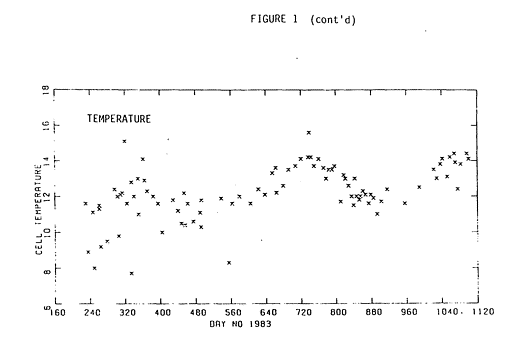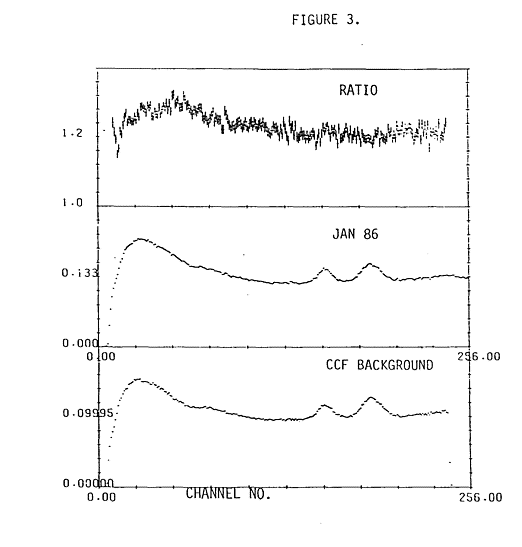THE HISTORY OF THE GSPC BACKGROUND AND GAIN
This report considers the evolution of the GSPC background and gain from launch
to the beginning of 1986. The qualified event (QE) rate, photomultiplier (P14)
rate, cell temperature and detector gain have been obtained from a sample of
background observations, selected at random since there is no variation
of the background over the range of altitude where the instrument is operated.
In Figure 1 the evolution with time of the PM rate, QE rate, detector gain and
cell temperature is shown. The detector gain is defined in terms of a parameter
called the gain conversion factor, GCF, which is the ratio of the average energy of the two lead lines measured from the gain
2.0 CCF background (channel no. 171.55), to that measured for a particular
observation. An increasing value of GCF corresponds to a decrease in detector
gain (i.e. any detected line feature will move to a lower channel number). The
time axis is given in day no. of 1983 (i.e. Day 1=1.1.83) such that day 1000 corresponds to 1985 day 269.
It is apparent from Figure 1 that the PM and QE rates have been increasing since
1983 day no.700 (December 1984). This is most probably caused by an increase in
the solar particle flux during the approach to solar maximum. There has also been
an increase in the GCF to 1.2, that is a 20% decrease in the detector gain. The
temperature of the gas cell has fluctuated between 10 and 14° C, and shows the
sinusoidal variation caused by the variation in the distance of the earth from
the Sun (ref. Express No.4 p.35).
In Figure 2 the GCF and QE rate are plotted as a function of PM rate and show a
very good correlation between both the GCF and PM rate and the QE rate and PM
rate. The discontinuity in QE rate from a linear relation which occurs above a PM
rate of 1950 ct/2 sec is caused by the progressive failure of the upper level
energy discriminator on the GSPC in early 1985. This allows additional events to
be registered as qualified (ref. Express No.11
p.2). Also shown in Figure 2 is
the GCF as a function of cell temperature. In this case there is no strong
correlation.
The gain of the GSPC is dependent on both the cell temperature and the overall
count rate seen by the PM tube. A correlation of the gain with the
cell temperature is to be expected because the light yield is dependent on the
gas pressure (and hence temperture). The GCF will be inversely proportional to
temperature, in degrees Kelvin. During some observations when the detector cooled
from 12 to 6° C, a marked decrease in gain can be seen. However, large excursions
in cell temperature only occur when sources are observed at beta angles above
130°. Since the 90-130° constraint was imposed in late 1983
the variation in cell temperature has been relatively small.
Figure 2 indicates that the dominant effect on the detector gain is the overall
increase in PM count rate. This is to be expected since the gain of the PM tube
is dependent on the amount of UV light received per second. The PM rate reflects
the total counts registered in the detector above a certain energy threshold,
that is background and any source in the field of view. The increase in the
background PM count rate from 1600 to 9200 ct/2 sec is comparable to that seen
when a bright source is observed (such as the Crab). There is no noticeable
change in the GCF after the slew onto a bright source (even for Sco X-1). However
the PM tube is also registering background events which are not counted if their
energy is below that of the lower level discriminator. This count rate is not
measurable but is probably very large, thus dominating the count rate dependence
of the PM tube.
While the correlation between PM count rate and GCF is good, it is not
recommended to use this to predict the gain of the GSPC for a particular
observation. There will still be a second order correction required because of
the temperatue dependence. In addition the gain will drift slightly as a function
of the time after switch on. The most accurate gain determination is still
obtained using the position of the lead lines.
The overall increase in the background has caused the QE rate to almost double
over the past year. About 20 ct/2 sec of this comes from the failure of the upper
level discriminator in early 1985. This failure does not affect the spectrum
obtained from the packet data. However, the overall increase in background does
seem to be associated with the slight change in the shape of the background.
Figure 3 shows the ratio of a background spectrum obtained in January 1986 to
that in the CCF (adjusted to a GCF = 1.0), indicating that the overall increase
in background is associated with a broad bump between channels 25 and 100.
Although this is a subtle effect, it does mean that for observations made in 1985
the re-normalisation of the CCF to the slew background will leave an excess below
channel 100.
To overcome this problem, time� dependent backgrounds are being generated and
will shortly be placed in the CCF. If the background continues to increase,
further updates will be provided. The procedure for background subtraction will
then be as follows:
1.
Ascertain the PM count rate in the slew preceeding the observation of interest. Remember that because the PM rate includes source counts
the on-source PM rate cannot be used. Alternatively, a reasonable estimate can be
obtained from Figure 1. Compare this with the PM rates of the CCF back grounds to
find the optimum CCF background to use.
2.
Obtain the gain for the observation from the lead lines. Readjust the CCF
background to the new gain value.
3.
Re-normalise the CCF back ground to the same count rate
as in the slew (channels 120-300 recommended). As a check the
renormalised CCF background should be subtracted from the slew
background to ensure that the residual spectrum is
clean.
4.
If the residual spectrum is not satisfactory it may be
necessary to generate a local background, and users should contact the
Observatory in the first instance. In general, however, the CCF backgrounds should be quite adequate.
N.E. White
F. Haberl




[EXOSAT Home]
[About EXOSAT]
[Archive]
[Software]
[Gallery]
[Publications]